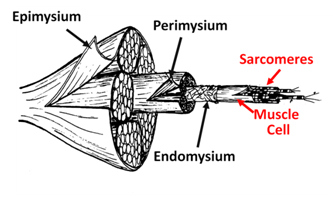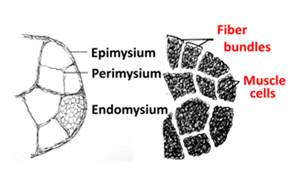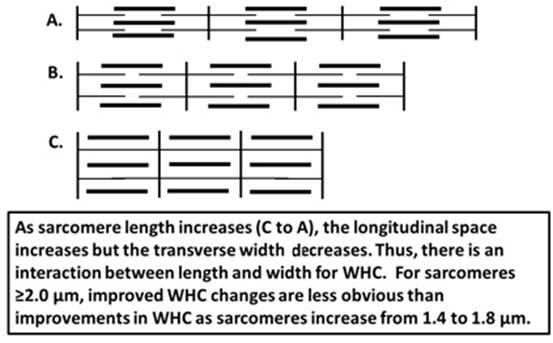Section II: Major Factors Affecting WHC
Objective of Section II: Using the background of Section I, become proficient with the major factors affecting WHC.
Some knowledge of the macro- and micro-structure of muscle is clearly necessary to understand how meat binds and retains water. Skeletal muscle is a unique organ containing all the tissues needed to support and generate energy required for locomotion. Many of these intrinsic structural properties of muscle affect the WHC of meat.
All muscles in a carcass are connected at its origin and insertion by a network of three layers of connective tissue, which is composed almost entirely of a protein called collagen. The thickest, outer layer of collagen is called the epimysium, which surrounds the whole muscle (FigII-1). The intermediate layer of connective tissue is called the perimysium; it connects to the epimysium and provides support by surrounding bundles of muscle cells. The thinnest layer of connective tissue is called the endomysium, which inner connects with the perimysium and surrounds and supports individual muscle cells. The epimysium may be removed from some muscles because it may be too tough, but this lowers muscle yields and may make it harder for the muscle to retain water. The two inner layers of connective tissue are more difficult to remove and thus have a significant impact on meat texture and tenderness. Collagen's influence on WHC is minor compared with the muscle cell contractile proteins. But, if the connective tissue layers are not damaged during meat fabrication the free and immobilized water are less likely to be lost.


Figure II-1. Structure of muscle connective tissue and muscle cells. Note: the connective tissue has black labels and the muscle cellular tissue is in red.
Individual muscle cells are packed with strands of protein that are assembled into myofibrils (Fig. II-2), which are long linear strands of repeating contractile units called sarcomeres. This complex arrangement of "thick and thin" overlapping proteins (myofilaments) can trap free water, provide capillary forces to help immobilize water, and electrostaticly immobilize water.

Figure II-2. Myofibrils and sarcomeres. The longer the sarcomere length and the greater the spacing between the structural proteins, the greater the WHC of the muscle.
- The "Space" Effect - also known as the Steric or Spatial Effect: This mechanism of water holding simply involves the total volume of spaces between muscle cells and cellular compartments that can fill with water (Fig. II-3). The rule-of-thumb is that longer sarcomeres (less contracted muscle) have more "open" space available to trap or hold water. An analogy would be a very damp cloth that is retaining considerable water, but when it is squeezed slightly, the water trapping spaces will decrease in size and water is expelled from the cloth.

Figure II-3. The space/steric effect of WHC. The combined effects of sarcomere length and width and extent of protein denaturation will affect the WHC.
- Net Charge Effect: The second mechanism of water holding involves the interaction between muscle pH and the net electrical charges on muscle proteins, which set an inherent electrostatic repulsion of similar charges and attraction of opposite charges. In general, the further the meat pH is above the isoelectric pH, the stronger the charges of the protein. The more distance between the muscle filaments, the higher the WHC of fresh, uncooked meat.
Meat processors have many opportunities to change WHC, either positively or negatively, by using slaughter and fabrication procedures that minimize protein denaturation and maximize the total volume of space in the microstructure of meat where water can be trapped or bound. Some of the major factors affecting WHC are briefly described below.